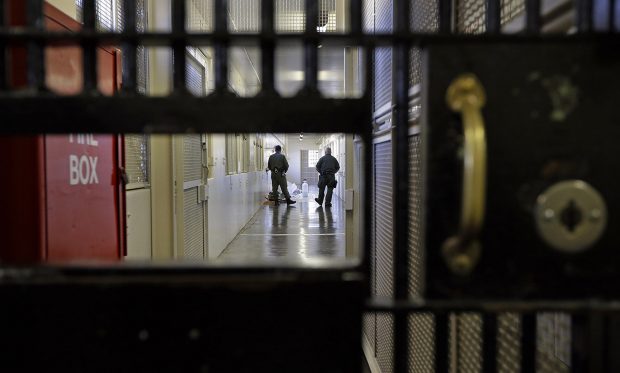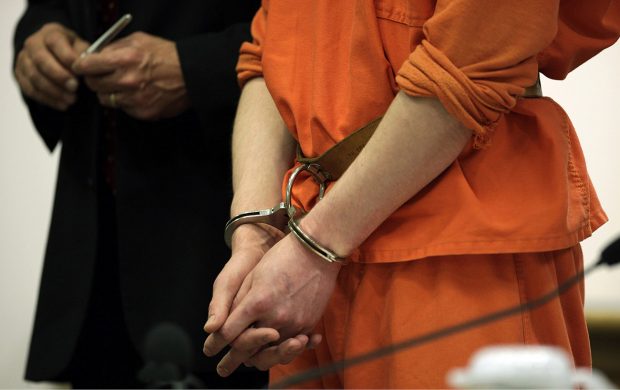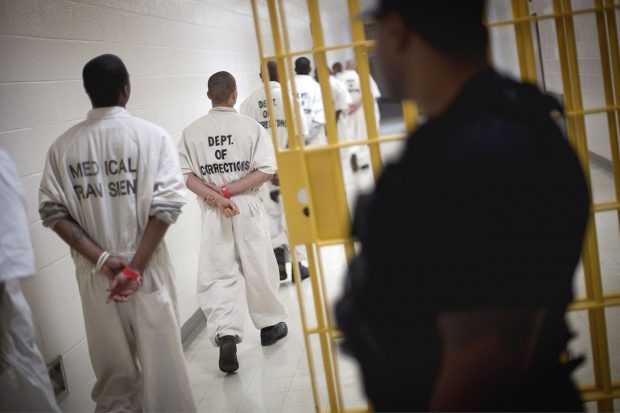A couple of summers ago, I was invited to speak to the Ninth Circuit Judicial Conference, a gathering of federal judges from the Western states, about the state of criminal justice and the campaign to reform it. I thought I had learned some lessons as editor of The Marshall Project, a nonprofit news organization focused on our troubled system of crime and punishment, but I’m not a lawyer. As if addressing a ballroom full of judges was not intimidating enough, I was scheduled to speak after Bryan Stevenson, the charismatic lawyer and champion of social justice. Anyone who saw his 2016 talk to a packed Bridges Auditorium at Pomona will know this is like having your cello recital follow Yo Yo Ma. I complained to my audience that this was a clear violation of the Eighth Amendment prohibition of cruel and unusual punishment. I think that’s the only laugh I got. With a bit of updating, however, the lessons stand up pretty well.
IN NOVEMBER 2016, a kind of fatalistic gloom settled over the advocates of reforming the criminal justice system. With a chest-beating president, a show-no-mercy attorney general and a Congress that has become even more polarized than it was in President Obama’s time, reform advocates said any serious fixes to the federal system were unlikely. So reformers consoled themselves by looking to the states.
After all, most of law enforcement, most of criminal jurisprudence and most incarceration takes place at the state or local level. My assignment today is to survey reform efforts at the state level and draw some tentative lessons from their experience.
“Reform” is one of those ambiguous words that mean different things to different people. For our purposes, I think of reform as something that aims to REDUCE the numbers of Americans who are removed from society and deprived of their freedom, and to do it WITHOUT making us less safe. In 1972, when I was near the beginning of my newspaper life a little north of here at The Oregonian, 93 out of 100,000 Americans were in state or federal prisons. By 2008 the incarceration rate had grown nearly six-fold, from 93 to 536, and it has hovered in that vicinity ever since. That’s not counting the hundreds of thousands held in county jails on any given day—or those confined in the juvenile justice system or immigrant detention. We are world leaders in locking people up.
Every year about 650,000 of those prisoners are released back into the world. We know that most of them will be unemployed a year later and that two-thirds of them will be rearrested within three years. As a strategy for keeping us safe, mass incarceration has not been a roaring success.

AP Photo/Ben Margot
LESSON #1 from the experience of the states is this: It is possible to reduce incarceration and crime at the same time. Between 2010 and 2015, 31 states reduced both crime and imprisonment. In the 10 states with the largest declines in imprisonment, the crime rate fell an average of more than 14 percent.
New York City, where I live, has slashed the crime rate while, simultaneously, sharply reducing arrests, incarceration—in particular the jailing of juveniles—and misdemeanor summonses. Stop-and-frisk is no longer routine. The city is a safer place and seems to have found the virtues of a lighter touch: New Yorkers who do not accumulate arrest records and jail time are more likely to stay employed, in families and out of trouble.
This does not mean that reducing incarceration necessarily leads to a drop in crime. Correlation is not causality. The question of why the crime rate declined is a subject of heated debate among social scientists. One of my colleagues at The Marshall Project wrote a piece we called “Ten Not Entirely Crazy Theories Explaining the Great Crime Decline.” One thesis our writer examined is that after Roe v. Wade the legalization of abortion meant fewer unwanted children who were more likely to become delinquents. Other researchers have surmised that removing lead from paint and fuel has made for a less criminogenic environment. Another theory credits technology: Anti-theft devices in cars and the spread of online banking made it harder for criminals to profit. Yet another theory is that the baby boomers just aged out of crime, which tends to be a young person’s game. Most experts give some credit to w the increased deployment and improved equipping of police. And, of course, some of the decline is a result of the fact that more bad guys were locked up, though that is a very expensive way to keep communities safe.
Whatever the factors responsible for the relatively low crime rate, the evidence from the states is that reducing incarceration is compatible with reducing crime. Obviously, a lot depends on HOW you reduce prison populations, which is where the states have much to teach us.
LESSON #2: The embrace of criminal justice reforms is bipartisan. This is one of those rare issues in our polarized country where activists on the left and right have found a patch of common ground.
On the left, criminal justice has become an obligatory plank in the platforms of virtually every candidate to be the Democratic presidential nominee. On the right, we have fiscal conservatives who see our prisons as wasteful, libertarians who see our handling of crime as another manifestation of oppressive big government, evangelical conservatives who see aspects of the system as inhumane.
There are of course issues where left and right still part company. Controlling the proliferation of guns remains a political third rail. The left wants to talk about race, and the right mostly does not. But on issues like pre-trial diversion, indigent defense, sentencing, parole, rehabilitation, solitary confinement, voting rights for the formerly incarcerated and bail and asset forfeiture, you found the Koch brothers arm-in-arm with the ACLU. In 2018, the First Step Act, a package of modest fixes to mandatory sentencing and prison conditions, passed Congress with huge bipartisan majorities. The iniquities and unintended consequences of American punishment have so captured public concern that even President Donald Trump voices an occasional platitude about “giving our fellow citizens a chance at redemption.” Trump signed the First Step Act into law, though his administration has shown little enthusiasm for enacting it.
Conservatives rightly boast that red states have often led the way, starting with Texas during the governorship of Rick Perry. In the past decade, that state has closed four prisons, reduced its incarceration rate by 20 percent and invested $240 million in alternatives such as drug treatment. The Texas experience is often cited as evidence that politicians can support so-called smart-on-crime reforms and live to tell about it.
The key to success in Texas was money. The state invested in alternatives, which meant judges had greater confidence that when they diverted someone to drug treatment, there would actually be drug treatment.
Two caveats regarding the Texas Story: First, Texas started out with one of the highest incarceration rates in the United States, so it had a long way to go; it is still the seventh most incarcerated state. Second, Texas accomplished its reductions by redirecting money, not by changing the legal infrastructure. Other conservative states—Georgia, South Carolina, Utah to name a few—have tackled the structure of criminal justice—reducing some felonies to misdemeanors, revising mandatory minimum sentences and three-strikes laws, funding community-based alternatives to incarceration, expanding eligibility for parole and removing barriers to reentry.
The most recent convert is Louisiana, a state long known among criminal justice reformers as a contender in every race to the bottom. Louisiana passed a remarkably comprehensive legislative overhaul. That feat was a product of strong leadership, intense lobbying by reform groups across the political spectrum and a corrections system bursting at the seams.

AP Photo/David Goldman
LESSON #3: Probably the most effective way to reduce incarceration is not to lock people up in the first place—at least not so many, and not for so long. In the last decade, 23 states have relaxed their sentencing laws—something Congress has so far been unable to do for the federal system. But I want to note a few other front-end measures that have been employed by states to keep people out of prison.
One is less reliance on money bail. The people most likely to spend time in jail awaiting trial are not the worst offenders but the poorest offenders; and even a short stint in jail increases the odds that an offender will ultimately end up in prison. A number of jurisdictions have curtailed the use of cash bail—most notably New Jersey, which now requires judges to hold hearings shortly after arrest to determine whether a defendant can be safely released before trial. Since the new procedure began, the average daily jail population has dropped 19 percent. [A referendum to replace bail with risk assessments in California will be on the ballot in November 2020.]
A second measure aimed at reducing prison intake is raising the age at which juveniles are thrown into the adult system, which too often subjects them to predators and leads many to careers in crime. In the last few years, Louisiana, South Carolina, New York and North Carolina have raised the age to what is now the national norm—18. There’s been talk of Connecticut becoming the first state to raise the cap to 21. In March 2018, Gov. Dannel Malloy announced the opening of a special corrections unit for young adults as old as 25.
A third way to slow the traffic into prisons is to provide better—and earlier—indigent defense. And a fourth is to elect prosecutors who don’t regard maximum prison sentences as the main measure of job performance. In recent years several jurisdictions—including Chicago, St. Louis, Houston, Denver, Tampa and Orlando—have elected prosecutors who campaigned on reform platforms.
LESSON #4: Don’t neglect the back end. There is abundant evidence of the effectiveness of college and vocational programs behind bars, regular contacts with family, reentry and parole and probation programs that have the resources and the mandate to land their clients safely back in society. A RAND Corporation study in 2014 concluded that “inmates who participated in correctional education programs had 43 percent lower odds of recidivating”—a verb that makes my inner English major cringe, but suggests a pretty good return on investment.
LESSON #5: Be wary of reformers who suggest you can cut incarceration drastically by setting free low-level, nonviolent offenders—in particular, low-level drug offenders. More than half of those incarcerated in state prisons are there for violent crimes. Only 16 percent are in for drug crimes, not all of them nonviolent. Decriminalizing marijuana will reduce incarceration, but to have any hope of restoring the incarceration rates of the 1990s means reducing sentences and stepping up rehabilitation for people convicted of violent crimes. The reality is: The reduction of incarceration is likely to happen incrementally. After all, the state that has been downsizing its prison population longest and most aggressively—California—has cut a bit more than 25 percent, and no other state has come close.

AP Photo/Ted S. Warren
LESSON #6: Be wary of reformers who suggest that prison reform inevitably means a huge windfall for taxpayers—10 billions of dollars back in our pockets. That remains to be seen, for two reasons: First, the alternatives to prison aren’t free. To keep crime in check, money not spent on actually confining offenders has to be spent on mental health and addiction treatment, more hands-on probation and, ideally, education, job training and housing support. Moreover, some states have found that the beneficiaries of prison—the corrections staff, the contractors, the politicians, the unions—are ferocious defenders of corrections budgets.
Here’s another way of looking at the cost of mass incarceration, though. The most commonly cited estimate of how much it costs to maintain the country’s prisons and jails is $80 billion a year. If you throw in things like health and pension benefits for prison staff, the cost to governments is more like $90 billion. But a 2016 report by researchers at Washington University in St. Louis attempted to add up the “social costs” of criminal justice as we practice it, a toll that includes lost wages, the cost of visitation, the higher mortality rates of both former inmates and their infant children, child welfare payments, evictions and relocations, divorces, diminished property values and the increased criminality of children with incarcerated parents. The bottom line they came up with was one trillion dollars a year, nearly six percent of GDP.

AP Photo/ David Goldman
LESSON #7: Metrics matter. It’s impossible to know what works and what doesn’t without reliable data, and reliable data is often in short supply. Our data guru at The Marshall Project, Tom Meigher, wrote a piece entitled “13 Important Questions About Criminal Justice We Can’t Answer”—can’t answer because the data is unreliable or unavailable. They include such questions as how many juvenile offenders graduate to become adult offenders, how many people have served time in prison or jail, how many people in America own guns and what percentage of inmates eligible for parole are actually granted release from prison. The Washington Post and the Guardian set out separately to count the number of civilians killed each year by police in the line of duty. The number they came up with was about 1,000. That is about double the official estimates from the Department of Justice—an astonishing margin of error.
As important as having good data is knowing what to do with it. That brings us to the debate underway in many states over the use of risk-assessment tools, basically tests aimed at helping make wise judgments at critical moments in the handling of the accused or convicted. Risk assessment tools are algorithms that examine a subject’s history to mitigate the chances of re-arrest. There are various tools for various applications: to help determine whether a defendant is a flight risk, how severe a sentence should be, whether an inmate is a fit candidate for parole and what kind of supervision an offender requires upon release. The left generally hates risk assessment, because the inputs may include factors like employment stability and past encounters with the law that weigh more heavily against communities of color. Advocates of risk assessment tests respond that a) they are getting better, both more accurate and less biased; b) they are meant to assist judges and parole boards, not preempt professional judgment; and c) properly used, risk assessment tools can assure people in the system get the support they need to stay out of prison.
I’m not a worshipper at the shrine of technology, but if I were in your robes, I think I’d rather have a sense of the odds.
LESSON #8: Many states are finding that incentives work better than mandates. A good example is an approach being used in about a dozen states. Take a defendant who is probably not a threat, who would do fine returned to the community under proper supervision. But the judge knows “proper supervision” is unlikely because the local probation system is threadbare. Suppose the state agrees that for every dollar it doesn’t have to spend locking people up, it will send 40 cents to the county to pay for more robust supervision? The state saves money, the county improves its oversight of former inmates, and the judge has greater assurance that the subject will be supervised.
And finally…
LESSON #9: The states have wide latitude to experiment, and they are seizing it, but the federal government sets a tone, and you will hear complaints from several states that the new administration has had a chilling effect on state legislatures. When the attorney general instructs federal prosecutors to charge the maximum, as Jeff Sessions did early in the Trump administration, when his response to a national opioid epidemic is to yearn for a revival of a discredited 1980s anti-drug program, that sends a message to state legislators contemplating new approaches.
Moreover, federal programs, especially Medicaid, which was expanded to include former inmates under the Affordable Care Act, can be essential to getting released offenders up on their feet.
In other words: What happens in Washington doesn’t always stay in Washington.
